Heidi Worley
Former Program Director

News reporting in the past year by PRB’s Women’s Edition participants has been instrumental in exposing violence against women to authorities in Kenya and Pakistan and forging a path to justice for women who were raped.
PRB’s Women’s Edition aims to improve print and broadcast coverage of stories that are important to women in developing countries—health, development, population, environment—by training female reporters and editors to look at these topics in depth. Women’s Edition, begun in 1994, is funded through USAID’s Informing DEcisionmakers to Act (IDEA).
One year after a 16-year-old girl was gang raped, only one of six suspects was put on trial this summer in Busia, in western Kenya. The girl, known as “Liz,” suffered a broken back and serious internal injuries, including a double fistula.
Last October, three months after the rape, Njeri Rugene, a reporter for the Daily Nation and member of PRB’s Women’s Edition, published the story of how Liz was attacked by six boys, three of whom she knew by name, and thrown into a pit latrine while walking home alone from her grandfather’s funeral. When the story broke that three of the boys had been arrested and told to mow the grass in the police compound as punishment, then set free, it sparked a storm of protest from Kenyans.
Amid intimidation and threats from the boys and their families, Liz and her family endured months of trauma before the justice system began to respond. With her injuries, Liz was unable to walk or even stand and was taken to a fistula hospital where medical bills for the surgical repair of her spine were huge, a surgery that was necessary before corrective surgery for her fistula. The frustrated doctors contacted Rugene because she had done an earlier story on their fistula work at the hospital. When the Daily Nation called Florence Mutua, a Busia County member of Parliament, she quickly got involved and police began investigating.
Rugene continued to report on the story and readers sent money to help pay the medical costs. The Nation Media Group, which publishes the Daily Nation, kept the story alive until the perpetrators were arrested and prosecuted. The media house offered to defray the medical costs by starting a campaign called “Stand Up For Liz, Help Her Walk Again.” More officials got involved, including Anne Waiguru, cabinet secretary for Devolution and Planning, and the case reached the National Assembly’s Committee on National Security. The protests drew support from individuals and women’s groups across Africa and globally, and more than 1 million people signed a petition calling for the arrest and prosecution of the suspects and disciplinary action against the police who originally mishandled the case.
Around the same time, another PRB Women’s Edition participant, Farahnaz Zahidi, a senior subeditor at The Express Tribune, told the story of a woman known as “M” who was gang raped in front of her husband and children in Tharparkar, a rural district in southeastern Pakistan. Behind the incident was a complicated set of events: Khano, the brother of M’s husband, had himself raped a woman, who was the wife of a man who had broken into Khano’s house and raped Khano’s wife. M’s rape had been retaliation against Khano, who had posted photos of the woman he had violated. In the end, three women were raped as revenge for the actions of the men in their lives.
M and her family sought police intervention and waged protests, but justice was slow and the perpetrators went into hiding. When Zahidi’s story broke on the front page, it got attention: Women’s groups and activists, including Amar Sindhu, who represented the Women’s Action Forum and was a member of the provincial Sindh Human Rights Commission, helped support the family through legal procedures. Zahidi continued to report on the story, and when she got the attention of the chief justice of Pakistan, the police promptly arrested the eight suspects. Because weapons were involved, the case went before the Pakistani anti-terrorism court, and within four months of the story breaking, each man was sentenced to 14 years in prison.
Zahidi wrote a follow-up story about the importance of the media in bringing justice. She told PRB, “My local informants thanked me profusely, saying this is the first time in their area that a poor woman’s plea has been heard and justice awarded. The woman and her family are thanking ‘good media’ !”
Women’s Edition participants come from different parts of the world and report from varying cultural perspectives. Through the two-year program, which offers international week-long seminars and study tours, they gain a new lens on reporting that helps them refine their professional role. Zahidi writes, “The ways in which some of us were able to make a difference are many…we ended up impacting our communities, armed with knowledge, experience, and encouragement we got from Women’s Edition.”
Study tours are a key component of the training. Women’s Edition journalists have visited:
Women’s Edition magnifies the determination and expertise these reporters already possess—to cover current news and write stories that have impact. Their stories, and the issues they expose, are gaining recognition—Rugene’s story won a Kenya Media Network on Population and Development award—and are fueling positive change for women.

PRB’s Women’s Edition program, funded by USAID, brings together senior-level editors, reporters, and producers from influential media organizations in developing countries to examine and report on women’s health and development.
This article profiles two Women’s Edition journalists: Shai Venkatraman from India and Farahnaz Zahidi Moazzam from Pakistan, who participated from 2010 to 2012. Learning and working together, these women are forging professional relationships that cross national, political, and cultural bounds.
Venkatraman described her participation in Women’s Edition, “It was a huge eye opener…a strong motivation to continue to focus on issues relating to public health. In India, these issues get short shrift, especially in TV. The PRB training helped me to push for these stories and…find different ways to peg these issues rather than wait for that big, breaking news moment.”
As a freelance journalist, blogger, and documentary filmmaker, Venkatraman focuses attention on women’s topics in India, including child marriage, discrimination and violence against women, and empowerment. Before going out on her own, Venkatraman was features editor for NDTV 24×7 in Mumbai for 12 years, where she reported on law, health, education, and women’s rights. As features editor, she guided young reporters on how to treat these topics sensitively and responsibly.
Venkatraman comments that Women’s Edition taught her “…two very critical things—the usage of numbers and data while writing about these issues, and the connection between health, the environment, and gender rights.”
Venkatraman earned a master’s degree in broadcast journalism from Northeastern University in Boston. Before that, she worked on TV news magazine shows and anchored for Asia Business News. In 2012 she was awarded the Laadli Creative Excellence Award for Best Documentary from UNFPA and Population First for the report “Born in Conflict,” on the state of public health care in Kashmir and Gadchiroli.
She blogs at http://shaivenkatraman.blogspot.com/ and tweets @shaivenkat.
Here is a sample of her work:
“Women’s Edition affected me as a person first, and in turn as a journalist,” Zahidi shared. “Having gotten this immense opportunity to learn, my motivation for sticking to purposeful journalism got stronger. The exposure helped me push my boundaries and think outside the box.”
Zahidi works as features editor for The Express Tribune in Karachi and focuses on human rights, gender, and peace building. “Reporting on gender and human rights as well as reproductive health is something that requires keen observation and good journalistic skills, as well as sensitivity,” she noted. “Topics like family planning or AIDS are sensitive and simultaneously daunting, especially in conservative societies.” Zahidi appreciated the field trips with Women’s Edition for helping her develop an understanding of indigenous methods of raising awareness and advocacy, and bringing communities on board, rather than alienating them.
Before joining the Tribune, Zahidi was a freelance journalist and columnist who contributed regularly to a variety of publications on topics pertaining to social issues in Pakistan, including gender, health, education, and the environment. Most of her freelance work was published by the Dawn Group of newspapers, which includes some of the most widely read in the country, as well as The Daily News, Inter Press Service, Asian Media Forum, and Newsline.
She blogs at http://chaaidaani.wordpress.com/ and tweets @FarahnazZahidi.
To learn more, read some of her stories:
Despite the strains between their respective countries, Venkatraman and Zahidi are friends and colleagues because of their participation with Women’s Edition. They both attribute Women’s Edition with fostering their relationships with other journalists around the world working on the same issues. “The best part of the PRB program was meeting journalists from so many different countries and with such varied experience…It was during a trip to Senegal that I realized female genital mutilation was alive and kicking in Mumbai, a city I was based in!” said Venkatraman.
Venkatraman and Zahidi have formed links that go beyond the two years they spent on the program. Zahidi shared that the bonds among the Women’s Edition participants expanded to people she saw on sites visits, including “a woman in the village in Senegal or a woman who was a fistula survivor in Addis Ababa’s Hamlin Hospital. Those women have stayed with me…in me.” Zahidi was able to travel to Pakistan’s conflict zones and saw the same kinds of suffering. She noted that each field trip was a learning experience, and “we were slowly pushed and encouraged to make inroads with policymakers.”
Heidi Worley is a senior writer/editor at the Population Reference Bureau.

(March 2011) Farah Zahidi Moazzam of Pakistan is one of 13 journalists from around the world in PRB’s current Women’s Edition. In honor of International Women’s Day, she recently traveled 6.5 hours by car outside of Karachi to the remote and food-insecure district Tharparkar. She wrote: “As this day celebrates the success and courage of women of the world, this write-up celebrates the women of Pakistan, particularly of Tharparkar. The success of these women and the people helping them is in fighting the odds and living with dignity.” These photos capture what she found there.
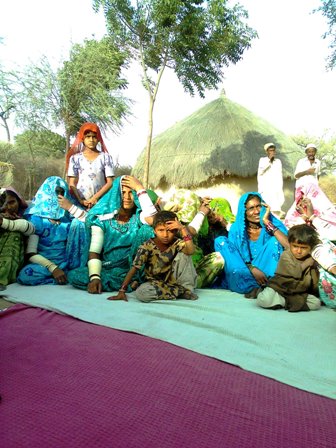
Tharparkar, a highly food-insecure region of Pakistan has a majority Hindu population. Both Hindus and Muslims coexist peacefully and we see both in this picture. The women wear white bangles up to their elbows if they are unmarried, and the entire length of their arm if married.
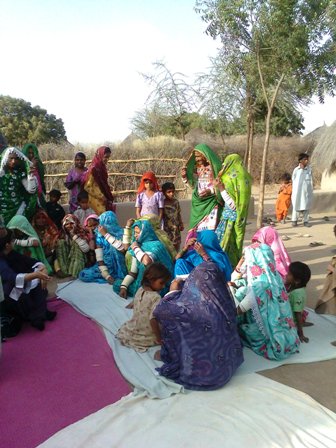
Amidst nothing but sand, the inhabitants of the village of Mithrao Chakar spread out their best linen to greet guests, and gather to meet us. Available to afford one or at best two meals a day of bread made of pearl millet and dried red cayenne pepper, their hospitality in spite of poverty is awe-inspiring.
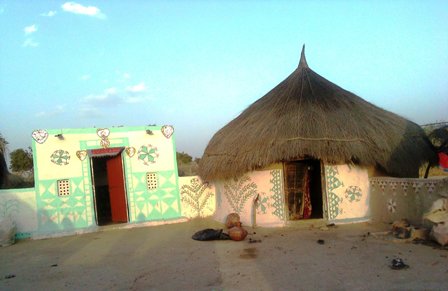
Art against the barren landscape of a desert…Natural dyes are used by women and children to paint their homes. Small circular clay huts covered with dried straw called khip covering the roof for insulation. Two tiny windows of approximately 6 by 10 inches is all the ventilation the huts have. They have tiny doors. Villagers, when asked, say that the doors are kept small so that the women stay healthy, active, and slim as they must bend down each time they go indoors.
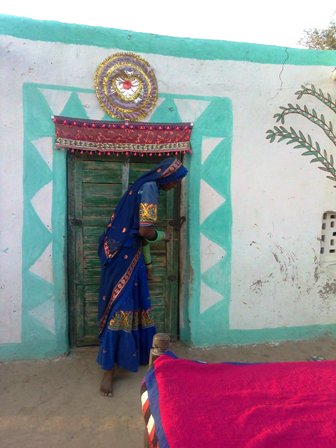
Red, purple, yellow, fuchsia. The women of Tharparkar dress in vibrant colors—perhaps as a defense mechanism again hunger and poverty.
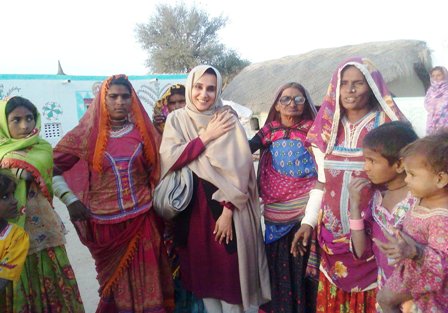
The women of Tharparkar and I sat together and talked. They held my hands. We talked about our children. I complimented their white bangles, which they wear up to their shoulders signifying they are married. We were women from very different backgrounds, connecting very comfortably. The women of Tharparkar, their inspiring struggles and hope in the face of it all have left an indelible mark on my heart.
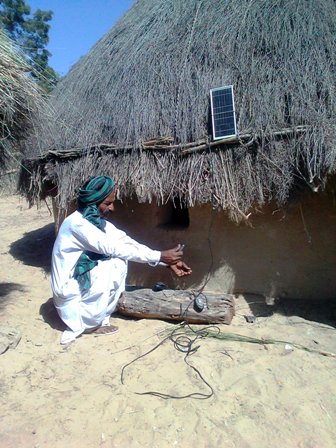
The power of technology! Even in such dire circumstances, the need to stay connected has forced small settlements of people to pool money and buy a tiny solar charger to harness the abundant sunlight in Tharparkar. The result? Many happy men of the neighborhood, such as this one, getting to charge their cell phones in an area where running water and electricity are a distant dream.
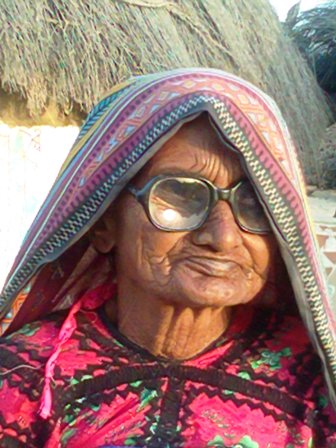
This seasoned face with wisdom etched over it is that of a daai (traditional birth attendant). The women of Tharparkar, like all of rural Pakistan, deliver babies mostly at home with the help of a daai, who usually inherits the profession from her mother. The daai usually charges $1.20 and gets a scarf as tip for helping deliver the baby and serving as a nurse for the mother. In case of a complication, a woman of this area might have to be taken in the state of labor to the nearest health facility on a camel or on her husband’s back for a journey of hours.

December 9, 2008
(December 2008) On Nov. 14, five of the 12 participants in PRB’s Women’s Edition seminar sat down to discuss reproductive health issues, the impact of the Women’s Edition seminar, and the challenges and opportunities of being a woman journalist.
1)
What are some major challenges involved with reproductive health in your country?
Zofeen T. Ebrahim, freelance journalist for Dawn newspaper, InterPress Service, IRIN, and Women’s Feature Service, Pakistan: The lack of political will, not the lack of resources.
Nadezda Azhgikhina, columnist, Delovoy Vtornik (Business Today), Russia: First of all, the health care system is destroyed with the collapse of the Soviet Union and the transformation of our economy. The lack of political will and lack of public awareness are other problems.
Chinyere Fred-Adegbulugbe, senior correspondent, The Punch, Nigeria: In Nigeria, it’s a combination of many things. We don’t have the infrastructure right now. The public health care system has virtually broken down…Some of the challenges women face are a lack of awareness and a lack of knowledge of the things they need to do to access good health care delivery.
Catherine Gulua, information and investigative journalist, Resonansi, Georgia: We are a developing country and women’s health care is very poor. We need to learn much from developed countries.
Catherine Mwesigwa Kizza, features editor, The New Vision, Uganda: Uganda faces so many problems from a poor and under-resourced primary health care system. This has an impact on so many things. At the moment, we have the issue of HIV/AIDS and because we have a poor health care system, you find that women cannot access basic emergency obstetric care so women are rushed to health clinics that are basic and not able to treat complications. Even when they are referred up the health care system, at times it is so congested they may not be able to access the services. The problems are enormous.
2)
What have you gained from this week’s training? How will you use what you have learned in your role as a journalist and what do you expect to gain over the next three Women’s Edition seminars?
Ebrahim: It opened my eyes to a whole new world called the new media which I was completely clueless about. I learned that it was alright to market (even if I may add aggressively and in many more ways than one) your stories. And meeting with so many wonderful and experienced journalists was so refreshing. It was indeed humbling to learn so many work in such difficult situations on difficult themes. I’m looking forward to developing a stronger and lasting liaison with these ladies and PRB…and wouldn’t want the network to end after the two-year period.
Kizza: The training helped explain several fundamental issues affecting women’s lives in many developing countries. I will only highlight one thing that was an eye opener. We always receive population reports and predictions but I had never been made to understand that demographers base them on certain assumptions (e.g., that the fertility rate of women gets to two children. In Uganda it has been 6-7 children since the 1960s). Without understanding such assumptions you cannot write accurate analysis or editorials…I intend to put into perspective all articles written on population and development issues when I return. Because I am an editor, I hardly get much time to write in-depth articles but I guide so many reporters as they write and this is one aspect I will explain to them and make certain is incorporated in our reporting. Uganda has one of the highest population growth rates and the political will to address this issue is weak. But if the issue is put into perspective, I hope we will have a change.
Azhgikhina: First, I got lots of inspiration, knowledge, and very important information both on new media technologies and the world situation in health in general. For me as a journalist from Russia, it was very important to have realistic impressions on global health issues as well as the situation in the developing world, and international strategies to improve women’s health and gender mainstreaming. It was important to confirm that women’s education and empowerment really lead to improvement of women’s health…I really appreciate …the great program … It was not a formal seminar from the very beginning, I should say, and it was extremely fruitful for the future network we hope to establish.
Fred-Adegbulugbe: I have gained quite a lot. When it comes to reproductive health issues, I would say that my mind was opened. The training has made it much more obvious to me that there is a need to get real creative as a journalist in order to let community members and policymakers pay attention to these issues. The training also empowered me by giving me so much information on issues to enable discussion and to write on them with better clarity, which is a very good thing for any journalist. And of course, the new media is an area I will really want to take advantage of to tell my stories…The information I have right now will make it much easier for me to present these issues to the readers in a better way. I am going to try as much as possible to do stories with the human angle. My expectation for the next training sessions? I would really like us to build up on how to tackle pregnancy-related deaths. The issue of empowering women should also be a focus, so women can take charge of their lives.
3)
What are some of the challenges and opportunities in being a women journalist in your country?
Ebrahim: It’s like any other working woman—juggling the house, housework, family and job…In Pakistan I might add, print media is not a well-paying job. It is much easier for those working in English language newspapers/magazines to get stories on sensitive topics past editors than it is for those writing in Urdu…At times, I feel I have an advantage being a woman as generally people are more amenable to meeting you, responding to your queries etc. …they cannot often say no. With the private TV channels coming out in huge numbers, and media enjoying a fair amount of freedom, these are interesting times for electronic journalism especially in a country which is predominantly illiterate. They play an enormous role in influencing the masses…however, with this power should come responsibility and that has often been overlooked in the race to be the first to report.
Kizza: Challenges of being a female journalist are many: One fundamental one for us in Uganda is that we operate in an environment dominated by men. It is not surprising—most of our readers, buyers are men. Most of the literate in the population are men, very few women can afford to buy a newspaper, so this affects the balance in coverage of issues because the media tends to focus on issues “that sell.” Issues that affect women therefore may not easily get prominence in terms of front page coverage though they easily get in-depth coverage as feature articles. And this is where the opportunity for female journalists is. There is no editor who will reject a well-done, in-depth feature. The constraint though is in terms of resources. In-depth reporting requires a lot of time and money and this discourages many journalists off these stories.
Azhgikhina: To be a woman journalist in Russia means to belong to the majority of professionals (now, up to 80 percent of all media workers in Russia are female, but media leadership is male dominated). It means to earn less than men….and to face more challenges and sexism in many ways. It also means to have a chance to speak out…and to combine reporting with human rights activities.
Fred-Adegbulugbe: First the pros: Being a female journalist makes it easier for me to gain access to individuals my male colleagues would have been unable to reach. There is always the tendency to trust a woman more (unless of course she betrays that trust). But I must say there are more challenges. As a female journalist, you really have to work hard. You must prove to your employers and colleagues that being a woman isn’t a disability. Often, they believe because you are a woman, you are not capable of treating serious issues, so it is up to you to prove them wrong.
4)
What is the media’s role in improving women’s health?
Gulua: I think the media is partly to blame for not having shows or programs on reproductive health or women health care. I think the media can have a leading role to make health care one of the priorities in life.
Fred-Adegbulugbe: The media has a very big role, but it has to be a media that is informed. That’s what makes a program like this very important because if the media don’t know, what are they going to talk about? That’s why I really appreciate what PRB is doing for equipping the media with the information they need. Once the media highlights the problems, any listening government would take action. So many people will get involved—NGOs, the international community, etc.— but it has to get out to the media first.
Ebrahim: I think that it’s a very interesting time for the media in Pakistan, especially for electronic media. We’ve seen a mushrooming of private television channels and FM radio. For a country that doesn’t have a high literacy rate, the media is influencing the general population. I think the media will play a very vital role in whatever issue that is taken up. The problem is that somehow the media has to get interested in reproductive health. But it seems it can be because journalism used to be a very male-dominated area but not any more. I can see a good relationship beginning here.
For more information, read an article on the November 2008 Women’s Edition seminar.
Eric Zuehlke is an editor at the Population Reference Bureau.
